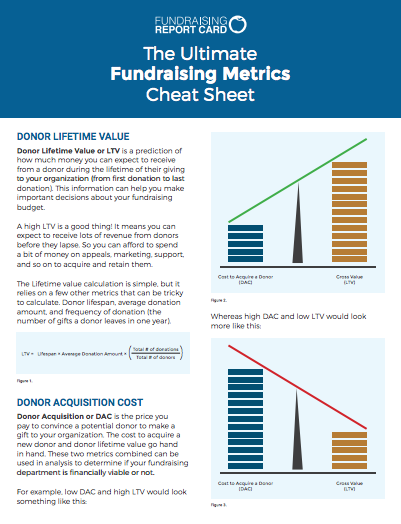Small development offices face a variety of obstacles on their path towards fundraising success. Three stand out in particular:
- Lack of time
- Lack of resources
- Lack of a plan
These struggles are not unique. Most everyone could use more time and resources, and although it may be hard to accept, we all could probably use a bit more structure in our personal “plan”.
On an individual level these hurdles are obvious (how frequently do you catch yourself saying, “if only there were more time in the day”), yet on the organizational level they are often overlooked or brushed aside.
At any company or nonprofit lack of time is a constant. Every organization could use more of it. Lack of resources on the other hand is commonly accepted as part of an organization’s culture (I’d love that new software but you know we don’t have room for it in the budget). And lack of a plan is directly correlated with the lack of time you (and your leadership) face. How can I steer the ship when I can hardly keep it afloat?
All three of these obstacles combined can (and frequently do) cause the demise of many organizations.
Small nonprofits, particularly fundraising departments within small nonprofits, are in an interesting and complex position. At a small development shop you’re tasked with not only maintaining and growing the financial engine of the entire organization, but also with engaging the community, chipping in with programs, building trust with key donors, and a whole host of other responsibilities.
It’s worth mentioning (in case you forgot, or no one has told you recently) that if you’re this person at your organization, you are awesome. You wear dozens of hats and manage to keep your fundraising operation running smoothly. Seriously, kudos to you small shop development staff.
But what if we could take some of the energy you currently use to put out all of your small fires and channel that towards your bigger, more overarching organizational goals? You know, your fundraising plan. How can we take all the little things that you do everyday and help make sure they align with your long-term strategy and plan?
I’m not here today with a snake-oil pitch for how you can get more time out of your day. Nor do I have some flashy product to sell that is the best “resource” you absolutely need. Nope. Instead, let’s address that third hurdle you face: creating and sticking to a strategic fundraising plan.
What is a plan?
Before we get too deep into this post, I need to share a link with you from the Harvard Business Review. Strategic Planning in Diversified Companies is a long, dense, and difficult-to-read article. What makes it worse is that the concepts and themes discussed are not directly applicable to your situation. So why am I sharing it here? Because it showcases the complexity involved in creating a plan. Sure, the strategies discussed in the article are for “large, complex corporations,” but they are also “essentially the same whether the organization is large or small.”
We’ll be taking a simplified approach to planning in this blog post, but it’s worth highlighting just how complex this problem is. It’s also worth keeping in mind when you come across future (or past) blog posts that try and suggest creating a strategic plan is easy. It isn’t.
So what is a strategic plan? And better yet, what is a strategic fundraising plan?
A strategic plan is a map. A map from the 17th century. Why the 17th century? Because the map is wrong. And unfortunately, so is your strategic fundraising plan.
Maps change, albeit slowly. Don’t believe me? Take a look at National Geographic’s wonderful, interactive comparison tool.
Maps change over time, and your strategic fundraising plan will as well. From the 17th century to today, cartographers were able to gather more information, collect more data and use more powerful tools to measure their surroundings. As a result, we have more accurate and detailed maps.
Your strategic fundraising plan is similar. It will start out as a rough outline. Over time, as you collect and measure more data it will become more refined and detailed. Eventually your plan will be as clear as Google Maps, you’ll be able to jump from section to section and feel confident in what you have produced.
The first-draft of your plan will include important milestones, themes and motifs. Just like a real map would include roads, parks, and attractions.
For a more serious and in depth explanation of what a strategic fundraising plan is, please reference some of these articles:
- How to Write a Successful Fundraising Plan
- Simple Steps to Creating a Written Fundraising Plan
- Elements Of The Perfect Fundraising Plan
For the purpose of this blog post, it’s simply important to know that a fundraising plan is, an ever-changing document that helps chart our course moving forward . Nothing more, nothing less.
How does data play a role?
If we continue with our simple map motif then it’s relatively easy to see why we want to use data in our fundraising plan. How do you think a map would look if someone arbitrarily added lines and marks where they saw fit? It wouldn’t be very useful.

The same concept applies with your fundraising plan, and that is where data plays a substantial role. A fundraising plan should not be opinionated, but rather data-backed and data driven. Strategic planning cannot guarantee good ideas or success, but it can greatly increase the odds of yielding a positive fundraising return. That’s our goal.
With that in mind, data plays a role in 3 key ways:
- Set realistic plan objectives
- Measure progress of plan execution
- Share a common currency for analysis
This isn’t the same thing as goal setting. Instead, it’s about turning data into strategic power. Let’s focus on how to start.
Use data to set realistic plan objectives
When it comes to creating a plan you’ll most likely start with your end-goal in mind. Raise more money, acquire more donors, etc. These high-level goals, or as I will refer to them, plan objectives, are milestones that you are attempting to reach.
It is important to note that the first draft of your fundraising plan is a guess. Remember, we mentioned above that your plan will change as you collect more data. With that being said, we cannot simply pull a number out of the sky and suggest that that is our fundraising goal. It’s important to leverage the data you have available to help set a realistic plan objective.
History is the best guide when it comes to forming plan objectives. It’s easy to say, “let’s make our fundraising goal to raise $1,000,000 this year,” but if last year’s revenues were only $250,000, it quickly becomes obvious that $1,000,000 is unrealistic. In order to create a more realistic plan, we’ll want to get our hands on key performance metrics. Donor growth rate, donation retention, etc. These metrics will help you determine what an attainable plan objective is.
To actually calculate these key performance metrics you have many options. First, check if your database calculates them for you, if not, then either use a tool like Fundraising Report Card® for free, or Excel. Either one will help you get the info you need.
Use data to measure progress towards goals
Now that we have the overarching fundraising plan objective, how do we know we are steering the ship in the right direction? That is where measurement comes in. Milestones, planted within the fundraising plan, are used as check-in points to make sure you are still on course.
This is again where data plays a role. In the past you may have had an informal practice of informing key stakeholders of your progress. In passing you might have mentioned to your Executive Director, “yes, last week’s event was a huge success, we raised a lot more money than the prior year!” Instead of doing that, use data to validate that you are on course with your high-level plan objectives.
Build milestones into your plan. Every quarter, or every six months, agree to dive into the data and check your key performance metrics. Are they trending in the direction you need them to?
Remember, the data is unbiased. It doesn’t care if you succeed or fail. This is a blessing, not a curse. Having milestones and procedure set around analyzing key performance metrics can help light a fire under the entire organization to help achieve overarching goals.
Get Data-Driven Email Updates
Use data as a common currency for analysis
Data is a tool for communicating across internal stakeholders. Data is also a language that everyone can understand. As you create milestones and benchmarks in your fundraising plan, share and explain the metrics that measure your progress towards achieving your plan objective.
For example, if your fundraising plan is to raise more money, you might want to share quarterly retention rates with your Executive Director. As retention rates trend up you’ll know you are slowly but surely on course to achieve your plan objective. And, at the same time you’ll be building confidence and trust with your peers and colleagues as they too see the progress you are making.
The more accessible you can make your key metrics to your colleagues the more they will buy in and trust what you are doing. The numbers won’t lie, and sharing those openly with other staff within the organization is a great way to create unity around your plan.
Applying this at your shop
Creating a strategic fundraising plan isn’t a one day event. You’ll want to take a mix of advice from this post, pair it with some of the recommended reading above, and identify which components will work best at your organization.
Ultimately, it is my hope that you’ll feel more comfortable with some of the concepts of data driven fundraising planning. Key performance metrics are your friend. Share data openly with colleagues and peers, and don’t be ashamed or afraid to alter your plan as you go.
Data is here to help support you. Leverage it correctly and your whole organization will benefit.








Zach, this is an excellent blog.that could help smaller nonprofits not be overwhelmed by the whole idea of creating a fundraising plan. A fundraising plan is essential to have, regardless of size, but data has to be an integral part of the planning process.
Thx for these powerful insights